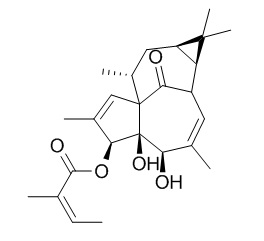20-Deoxyingenol 3-angelate
20-Deoxyingenol 3-angelate and ingenol 20-acetate 3-angelate are known as promoters of tumors of mouse skin. 20-Deoxyingenol 3-angelate can induce significant platelet aggregation accompanied by induction of phosphorylation of PKC substrates in platelets, it is a protein kinase C (PKC) activator.
Inquire / Order:
manager@chemfaces.com
Technical Inquiries:
service@chemfaces.com
Tel:
+86-27-84237783
Fax:
+86-27-84254680
Address:
1 Building, No. 83, CheCheng Rd., Wuhan Economic and Technological Development Zone, Wuhan, Hubei 430056, PRC
Providing storage is as stated on the product vial and the vial is kept tightly sealed, the product can be stored for up to
24 months(2-8C).
Wherever possible, you should prepare and use solutions on the same day. However, if you need to make up stock solutions in advance, we recommend that you store the solution as aliquots in tightly sealed vials at -20C. Generally, these will be useable for up to two weeks. Before use, and prior to opening the vial we recommend that you allow your product to equilibrate to room temperature for at least 1 hour.
Need more advice on solubility, usage and handling? Please email to: service@chemfaces.com
The packaging of the product may have turned upside down during transportation, resulting in the natural compounds adhering to the neck or cap of the vial. take the vial out of its packaging and gently shake to let the compounds fall to the bottom of the vial. for liquid products, centrifuge at 200-500 RPM to gather the liquid at the bottom of the vial. try to avoid loss or contamination during handling.
Life (Basel).2022, 12(12):2107.
Phytomedicine.2023, 114:154813.
Functional Ecology2020, doi: 10.1111.
J of Physics Conference Series2019, 1349(1)
Molecules.2020, 25(21):5091.
Int J Mol Sci.2020, 21(8):2790.
Int J Mol Sci.2023, 24(22):16465.
Front Aging Neurosci.2018, 10:269
Purinergic Signal.2024, doi: 10.1007.
Biochem Biophys Res Commun.2018, 505(1):261-266
Related and Featured Products
J Cancer Res Clin Oncol. 1998;124(6):301-6.
Dietary cancer risk from conditional cancerogens in produce of livestock fed on species of spurge (Euphorbiaceae). III. Milk of lactating goats fed on the skin irritant herb Euphorbia peplus is polluted by tumor promoters of the ingenane diterpene ester t[Pubmed:
9692836]
Special procedures were developed to investigate poisonous milk of lactating goats fed experimentally on aerial parts of the herb Euphorbia peplus L.
METHODS AND RESULTS:
In extracts of the milk, weakly irritant in the mouse-ear assay, three diterpene ester toxins were detected by techniques of high-performance liquid chromatography. They are of the ingenane structural type: Euphorbia factor Pel (ingenol 20-acetate 3-angelate), Euphorbia factor Pe2 (20-Deoxyingenol 3-angelate) and Euphorbia factor Pe4 (20-deoxyingenol-6alpha,7alpha-epoxide 3-angelate). From goats milk collected 15 days after cessation of the experimental feeding period, extracts were completely free of diterpene ester toxins. The toxins polluting the milk are identical to diterpene ester entities occurring in the aerial parts of E. peplus. Of these, Euphorbia factors Pel and Pe2 are known as promoters of tumors of mouse skin. Apart from the toxic Euphorbia factors, the non-toxic parent alcohol ingenol was also detected in the milk. It is absent in the plant, and may have been generated metabolically from a certain portion of the toxic diterpene esters picked up by the goats from their fodder.
CONCLUSIONS:
The results presented here provide, for the first time, data for a novel interpretation of the locally high incidence of esophageal cancer observed in certain areas in the Caspian littoral of Iran, associated with a greater consumption of goat's (and sheep's) milk.
Planta Medica, 2015 ,81(16).
Evaluation of protein kinase C-activating effect of different type of Euphorbia diterpene phorbol esters in human platelets[Reference:
WebLink]
Therefore, finding novel phorbol diterpene esters from natural sources seems to be an important task. Human platelets contain 5 isoforms of PKC, including α, β, δ, θ, and ζ, and activation of PKC results in platelet aggregation. Therefore, in the present study, platelets were used to evaluate PKC-activating activities of five phorbol diterpene esters, which were isolated from European Euphorbia species.
METHODS AND RESULTS:
We found that 20-Deoxyingenol 3-angelate (1) and 12-deoxy-16-hydroxyphorbol-20-acetate-6-angelate-13-isobutyrate (2) induced significant platelet aggregation accompanied by induction of phosphorylation of PKC substrates in platelets. In contrast, two jatrophanes (3, 4), and a myrsinol-type diterpene (5) neither induced platelet aggregation nor PKC activation. PKD, a substrate of PKCδ, was phosphorylated in response to 1 and 2, indicating that these two compounds are able to activate PKCδ.
CONCLUSIONS:
Our results suggest that 1 and 2 are PKC activator, but their selectivity to different isoforms of PKC remains to be determined.



